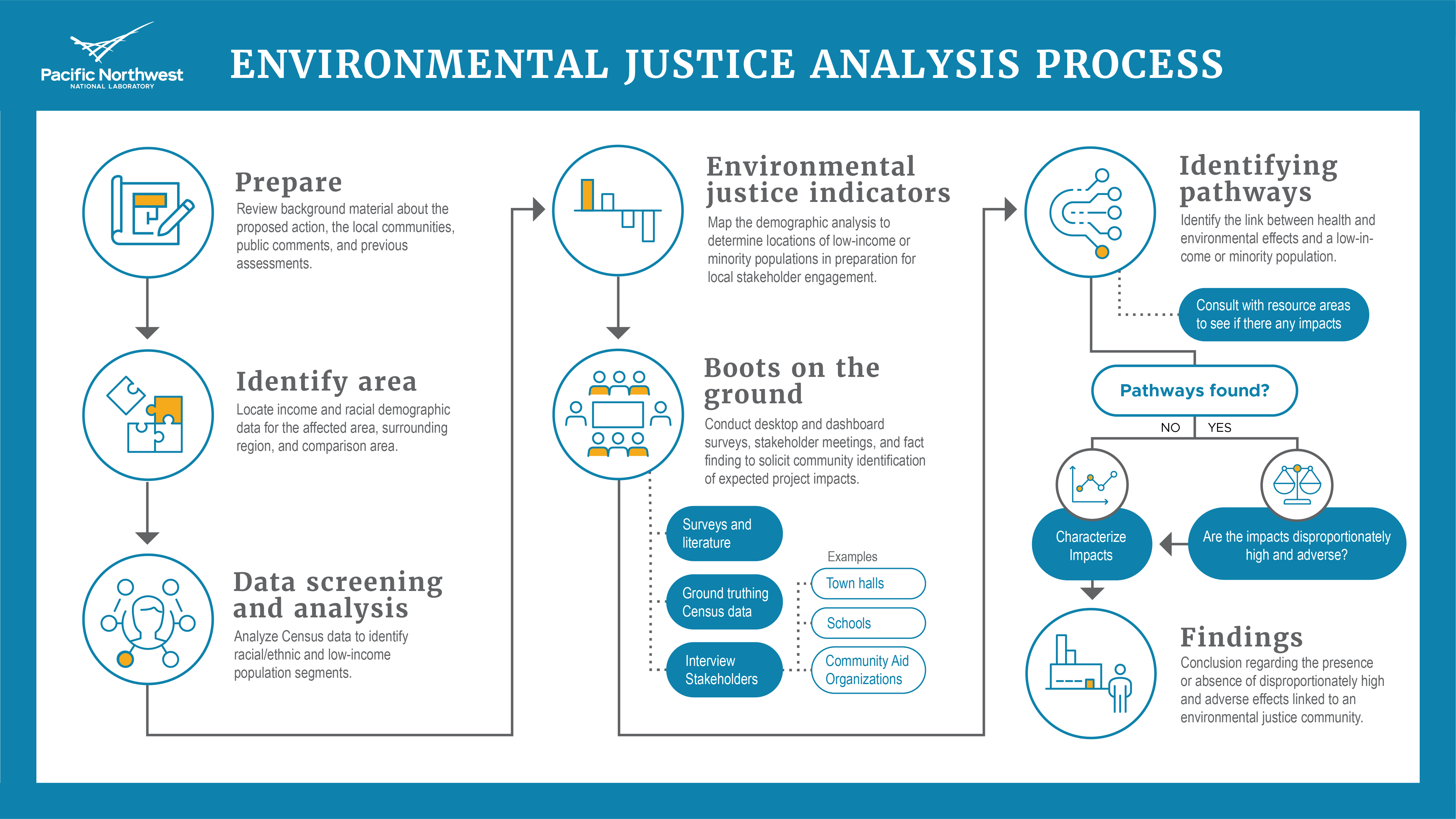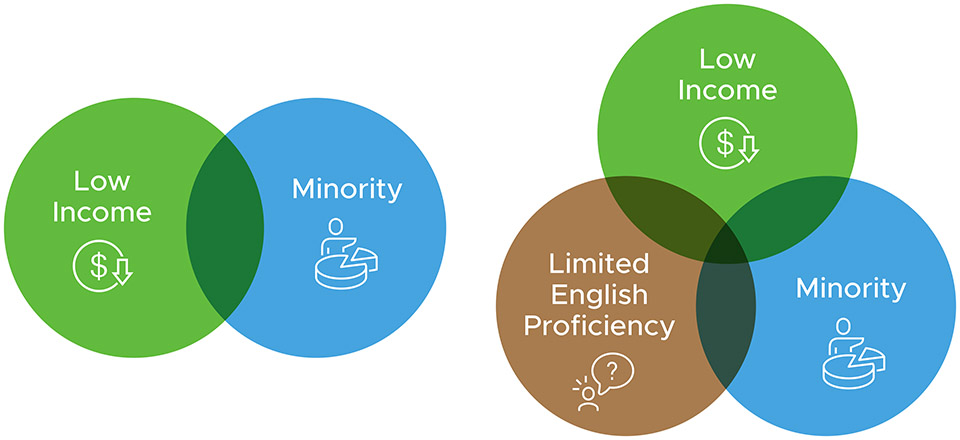Limited English proficiency-it's a term that can be applied to more than 26 million households in the United States. It pertains to the broad swath of individuals in America who do not speak English as their primary language and who have limited ability to understand English.
Considering the magnitude of this number and its implications for comprehending health and safety messages, it's a potentially important metric for federal energy agencies to consider when addressing environmental impacts from their programs, policies, and activities on people of color, Tribal Nations, and disadvantaged communities.
Enter environmental justice (EJ)-the fair treatment and meaningful involvement of all people regardless of race, color, national origin, or income, with respect to the development, implementation, and enforcement of environmental laws, regulations, and policies. The option for federal energy agencies to expand key EJ metrics, like limited English proficiency, for data gathering and analysis is one opportunity among many as part of new policies set forth by the U.S. government that put renewed emphasis on EJ. The EJ policies are:
- EO 13985, "Advancing Racial Equity and Support for Underserved Communities Through the Federal Government" (86 FR 7009)
- EO 13990, "Protecting Public Health and the Environment and Restoring Science to Tackle the Climate Crisis" (86 FR 7037)
- EO 14008, "Tackling the Climate Crisis at Home and Abroad" (86 FR 7619)
- Memorandum on Tribal Consultation and Strengthening Nation-to-Nation Relationships
To support federal energy agencies in meeting these new policies, Pacific Northwest National Laboratory (PNNL) is identifying the mechanisms and practices that could enhance agencies' existing EJ programs, policies, and activities.
"It's easy to get caught up in the challenges of our rapidly evolving energy system, but this growth also means there are renewed opportunities for environmental justice," said Ellen Kennedy, an Earth scientist and environmental justice and stakeholder engagement researcher at PNNL. "These federal policies are highlighting the importance of addressing EJ as a fundamental aspect of the environmental decision-making process."
Keeping pace with environmental justice best practices
A new independent assessment by PNNL, "Enhancing Environmental Justice Activities at the U.S. Nuclear Regulatory Commission," is a prominent example of how PNNL experts are supporting federal agencies in understanding revisions to regulatory EJ mandates and national policy, and helping them keep pace with EJ best practices.
PNNL Senior EJ Advisor, Dave Anderson, explained, "some actions associated with the nation's energy system can adversely affect human health or result in environmental hazards with disproportionately high and adverse impacts to affected populations. For instance, siting a power plant that might cause health impacts to a community of color. We're helping ensure that potential impacts from environmental and health hazards are properly disclosed and that all communities have meaningful engagement in a decision-making process that supports a healthy environment."
For the Nuclear Regulatory Commission (NRC), PNNL provided its experts' perspectives on EJ best practices, taking into account NRC's existing statutory authorities and mission. PNNL's report assisted NRC staff in their systematic review of the agency's programs, policies, and activities, and is now an important reference for the NRC. PNNL continues to support the NRC in assessing whether EJ has been appropriately considered and addressed in its activities, such as environmental reviews, given the NRC's mission.

Enhancing environmental justice activities
One area covered in the report is an opportunity to improve how Census data is used to identify EJ populations. PNNL recommends agencies consider expanding their assessments in response to Executive Orders. This could include implementing metrics like limited English proficiency, as well as more specific demographic groups, religious minorities, gender identity and sexual orientation, persons with disabilities, residents in rural areas, and persons disadvantaged by energy costs or persistent inequality.

For example, as a partner to the FutureGen Alliance in its identification of EJ communities specific to a carbon capture and storage project corridor in Illinois, PNNL conducted Census data analysis to determine if the state's minority and low-income populations were underrepresented. PNNL also helped the Alliance carry out ground reconnaissance of the project corridor to validate Census data and determine if additional EJ-related characteristics were present. The Alliance leveraged PNNL's technical input to inform a Department of Energy Environmental Impact Statement.
Environmental justice recommendations
In their approaches to EJ, PNNL experts apply their proficiencies in social science and demography to conduct assessments that examine environmental, cultural, and socioeconomic impacts of proposed actions, as well as trade-off assessments.
PNNL also offers these suggestions to shape EJ approaches:
- Enhance internal organizational approaches for conducting EJ assessment, such as creating community review panels.
- Initiate community outreach earlier in the project planning process in a manner that is tailored and customized to meet community needs.
- Create partnerships with community organizations and facilitate stronger relationships between communities vulnerable to disproportionate environmental impacts.
The road ahead
PNNL's recommendations were used to inform NRC's EJ paper, SECY-22-0025, and supporting enclosures that were submitted by NRC staff to the Commission on March 29, 2022. The paper contains recommendations for NRC to consider and approve regarding EJ-related activities within the agency. Staff at PNNL also prepared the public comment summary report and supported a small benchmarking effort.
PNNL's EJ team continues to field requests for support in responding to the U.S. government's EJ goals. Researchers like Kennedy and Anderson expect continued interest, especially given the increasing impacts of climate change and Environmental Protection Agency data showing the most severe harms fall disproportionately upon underserved communities.
"Across PNNL, we have experts studying climate change impacts, from extreme heat to flooding to severe storms, and they're concerned about those impacts potentially being disproportionate to the people in our communities who are least able to prepare and cope," said Kennedy. "I find hope in seeing federal agencies take action in reviewing how their programs, policies, and activities will address environmental justice. I do feel like our shared efforts will result in more individuals and communities being included in decisions that affect their environment."






